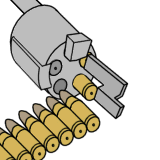Continued from:
http://thefiringline.com/forums/showthread.php?p=5117307
First let's look at some of the tooling I've had to score for all this:

In our last installment I talked about "Plan B", in which the cylinder is radically shortened to make it proper for the 9mmPara caliber.
Well I am going to have to do that - turns out, no choice. The Manson reamer isn't really long enough to do anything else!
But, in order to use the frame as a jig to at least mark the cylinder bores (line boring) there's going to have to be a tweak made.
As near as I can tell, here's how it'll go:

See, I was going to use the original barrel (or a short section of it) to act as a drill guide. But I can't do that. It's .357" inside, I need a guide for a 9mm drill bit which turns out to be about .345".
So, the best guide for a given drill is a hole made by that same exact drill. Right?
All of the drilling and preparation of the "stub" will happen on the lathe. Spun perfectly centered, checked first with the dial indicator. That stub will be a damned accurate little piece of metal. And then having served as the guide for the drilling on the cyinder, why not keep right on using it as the guide for the otherwise too-damn-narrow Douglas barrel core?
And in this setup, I'll be able to screw-adjust the barrel/cylinder gap much like you can on a Dan Wesson...
I don't know if this is insanity or genius . If anybody has any clue which, sing out, esp. if I'm about to seriously blooper this...
. If anybody has any clue which, sing out, esp. if I'm about to seriously blooper this...
http://thefiringline.com/forums/showthread.php?p=5117307
First let's look at some of the tooling I've had to score for all this:

In our last installment I talked about "Plan B", in which the cylinder is radically shortened to make it proper for the 9mmPara caliber.
Well I am going to have to do that - turns out, no choice. The Manson reamer isn't really long enough to do anything else!
But, in order to use the frame as a jig to at least mark the cylinder bores (line boring) there's going to have to be a tweak made.
As near as I can tell, here's how it'll go:

See, I was going to use the original barrel (or a short section of it) to act as a drill guide. But I can't do that. It's .357" inside, I need a guide for a 9mm drill bit which turns out to be about .345".
So, the best guide for a given drill is a hole made by that same exact drill. Right?
All of the drilling and preparation of the "stub" will happen on the lathe. Spun perfectly centered, checked first with the dial indicator. That stub will be a damned accurate little piece of metal. And then having served as the guide for the drilling on the cyinder, why not keep right on using it as the guide for the otherwise too-damn-narrow Douglas barrel core?
And in this setup, I'll be able to screw-adjust the barrel/cylinder gap much like you can on a Dan Wesson...
I don't know if this is insanity or genius


